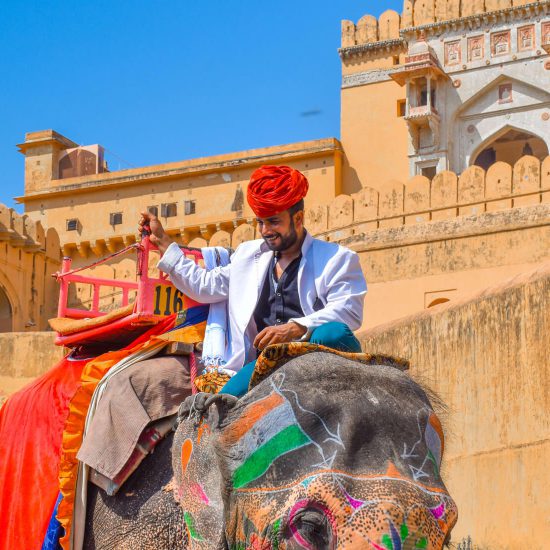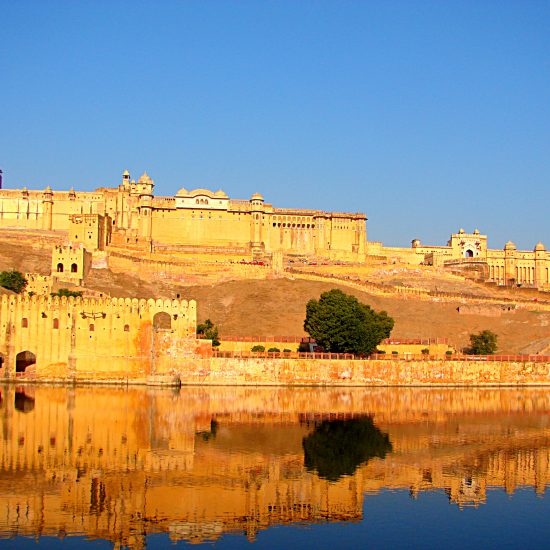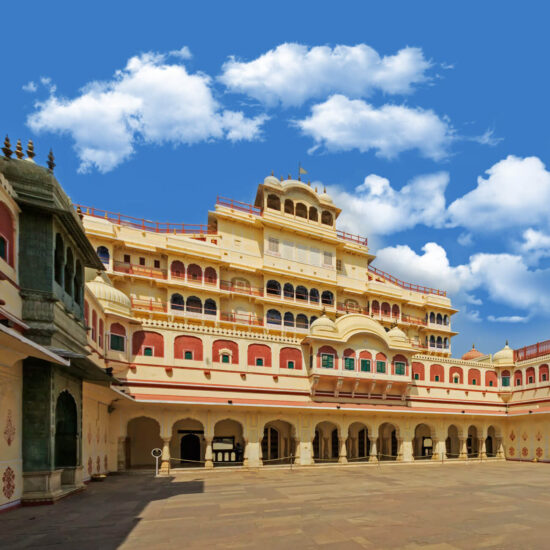North India Special Tour
€1999 per person
Special Discounts:
- Early bird – 15%
- Couple – 20%
- Family – 25%
- Group – 35%
Tour Information
Tour duration: 18 Days (17 nights)
Starting from: New Delhi
Departure from: New Delhi
Total cities covered: 8
(Delhi, Varanasi, Agra, Jaipur, Udaipur, Jodhpur, Jaisalmer, Bikaner)
Included in the Package:
- 24×7 Online and physical assistance by a professional team during the tour from arrival till departure
- Visa assistance.
- Flight booking assistance.
- Airport pickup from Delhi and drop-off transfer arrangements for departing airport.
- Stay in 100% hygienic, sanitized and personally inspected hotels by We Fly India team (minimum 3 star hotel and highly rated by booking.com etc.).
- Breakfast included.
- Personal transport (A.C) with professional drivers up to 100 miles.
- Domestic flight tickets for over 100 miles distance.
- English, Italian, Dutch, Hindi, Punjabi speaking guide during the tour
- Handpicked destinations.
Not included in the package:
- International flight tickets.
- Wine & other alcoholic beverages.
- Lunch & dinner.
- Club visit during the stay.
- Museum tickets, extra activities that are not mentioned in the package description.
- Insurance for personal injury and 3rd party damage.
Day 1,2: Arrival & Sightseeing in New Delhi
Main attractions:
India GateThe official name Delhi Memorial, originally called All-India War Memorial, monumental sandstone arch in New Delhi, dedicated to the troops of British India who died in wars fought between 1914 and 1919.
Red fortThe Red Fort or Lal Qila is a historic fort in Old Delhi, Delhi in India that served as the main residence of the Mughal Emperors. Emperor Shah Jahan commissioned the construction of the Red Fort on 12 May 1638, when he decided to shift his capital from Agra to Delhi.
Akshardham templeDelhi's Akshardham Temple made it to the Guinness Book of World Records for being the largest Hindu temple complex in the world. The grand, ornately, ancient-style and the hand-carved stone temple was built without any structural steel, and took 11,000 artisans and volunteers to construct it.
Humayun tombThis tomb, built-in 1570, is of particular cultural significance as it was the first garden tomb on the Indian subcontinent. It inspired several major architectural innovations, culminating in the construction of the Taj Mahal.
Lotus templeIt is known for its beautiful flower-like architecture and marvelous ambiance that makes it a popular tourist attraction for people of all faiths. The Bahai Lotus Temple is one of the world's most beautiful religious buildings and a must-visit when in Delhi.
Qutub MinarQutub Minar is one of the highest minarets in India with a height of 73 meters. It is a UNESCO World Heritage Site and the tallest brick minaret in the world. This 12th-century minaret is considered the earliest Islamic structure in India with both Arabic and Brahmi inscriptions.
Gurudwara Bangla SahibGurudwara Bangla Sahib is known as much for its religious significance as for its splendid architecture. In addition to the Gurudwara and water tank, the complex also contains a community kitchen aka langer(community kitchen), a museum, an art gallery, a school, and a hospital and a library.
Kingdom of dreamsThe Kingdom of Dreams is India's flagship live entertainment hub. Located in Gurgaon, Haryana, KOD as it is popularly called is spread over 6 acres and offers visitors numerous entertainment options. To enjoy arts and culture from across the country head to the Culture Gully in the Kingdom of Dreams.
Day 3,4: Varanasi
Main attractions
Assi Ghat ArtiAssi Ghat is the southernmost ghat in Varanasi. To most visitors to Varanasi, it is known for being a place where long-term foreign students, researchers, and tourists live. Assi Ghat is one of the ghats often visited for recreation and during festivals.
Dhamek StupaDhamek Stupa is one of the most important sights in Sarnath and it's mostly due to its antiquity and significance of being the exact spot of Buddha's first sermon. It was here that he revealed the eightfold path leading to nirvana.
Kashi Vishwanath Golden TempleThe Kashi Vishwanath Temple is one of the most famous Hindu temples dedicated to Lord Shiva. It is located in Vishwanath Gali of Varanasi, Uttar Pradesh in India. The Temple stands on the western bank of the holy river Ganga, and is one of the twelve Jyotirlingas, or Jyotirlingams, the holiest of Shiva Temples.,
Ramnagar FortRamnagar Fort is a sandstone-fortified structure that was built in the 18th century. It is located near the river bank. Kashi Naresh, the king of Varanasi, constructed the building. The present king, Anant Narayan Singh lives in the fort now. The fort might not have its prime shine now, but, it is an aesthetically pleasing structure.
Dasaswamedh GhatThe lively atmosphere of the Dasaswamedh Ghat makes it one of the best places to visit in Varanasi. This tourist attraction is a swirling hodgepodge of flower sellers touting bright blossoms, boat operators hawking rides along the Ganges River, and sadhus (holy men) with face paint. You can spend hours people-watching in this area during the day. Hindu priests put on the Ganga Aarti every night at the Dasaswamedh Ghat, starting at around 7 pm.
Day 5,6: Agra
Taj Mahal
An immense mausoleum of white marble, built-in Agra between 1631 and 1648 by order of the Mughal emperor Shah Jahan in memory of his favorite wife, the Taj Mahal is the jewel of Muslim art in India and one of the universally admired masterpieces of the world's heritage.
Agra FortAgra Fort is a historical fort in the city of Agra in India. It was the main residence of the emperors of the Mughal Dynasty till 1638 when the capital was shifted from Agra to Delhi. The Agra Fort is a UNESCO World Heritage site. It is about 2.5 km northwest of its more famous sister monument, the Taj Mahal.,
Taj MuseumThe origin of the Taj Museum goes back to 1906 when it was established at the instance of Lord Curzon(Viceroy of India 1899 to 1905) in two hexagonal rooms on the west side of the main entrance gateway to the Taj Mahal. Now Taj Museum is housed in the Western Jal Mahal which is the part of the Taj Mahal Complex.,
Sheesh MahalThis Hall of Mirrors in Amber Fort is made entirely of white marbles and red sandstone. This is one of the famous forts of Rajasthan because of its construction. The walls of Sheesh Mahal are covered only with mirrors that reflect any small ray of light to the entire fortress known for Mirror reflections.
Tomb of I'timād-ud-DaulahTomb of I'timād-ud-Daulah is a Mughal mausoleum in the city of Agra in the Indian state of Uttar Pradesh. Often described as a "jewel box", sometimes called the "Bachcha Taj" or the "Baby Taj", the tomb of I'timād-ud-Daulah is often regarded as a draft of the Taj Mahal.
Mehtab Bagh(Moonlight Garden) was built by Emperor Babur in the early 1500s and the width of the gardens perfectly aligns with those of the Taj Mahal. It was then famously known as the “moonlit pleasure garden” when Emperor Shah Jahan identified it as the ideal site from which to admire the mausoleum.
Subhash EmporiumSubhash Emporium (also known as the Marble Emporium)is widely acclaimed for reviving and promoting the ancient art of "Prachinkari in marble" (marble inlay art) and is considered the top manufacturer and exporter of inlay table-tops, boxes, vases, coasters, plates and marble handicrafts. You can find the best quality pieces at fair prices here.
Day 7,8,9: Jaipur
was the first planned city of the Mughals to be marked by magnificent administrative, residential, and religious buildings comprised of palaces, public buildings, mosques, and living areas for the court, the army, the servants of the king, and an entire city.
Nahargarh FortOne of the major tourist attractions of Jaipur, Nahargarh Fort is noted for its extended wall which connects it to the Jaigarh Fort. Nahargarh Fort was built in 1734 by Maharaja Sawai Jai Singh II, founder of Jaipur, on the Aravalli hills, as a retreat place.
Amber PalaceAmber Fort or Amer Fort is a fort located in Amber, Rajasthan, India. Amber is a town with an area of 4 square kilometers located 11 kilometers from Jaipur, the capital of Rajasthan. The town of Amber and the Amber Fort was built by Maharaja Man Singh Kachawaha Rajputs.
Hawa MahalHawa Mahal is famous because of its amazing and unique architecture. 953 windows or jharokhas are beautifully incorporated in the honeycomb design of this palace. In addition to providing a window to the outside world for the royal women, these windows helped in keeping the palace airy and cool.
Jal MahalNo wonder, the Jal Mahal Palace in Jaipur is among the most photographed structures in India. It is also a paradise for bird watchers as various species of local and migratory birds flock to this lake. As the palace remains submerged in a lake, a boat ride is the only way to reach it.
City PalaceJaipur is the present-day capital of the state of Rajasthan, and until 1949 the City Palace was the ceremonial and administrative seat of the Maharaja of Jaipur. The Palace was also the location of religious and cultural events, as well as a patron of arts, commerce, and industry.
Albert Hall MuseumThe Albert Hall Museum in Jaipur, is the oldest museum of the state and functions as the state museum of Rajasthan, India. The building is situated in Ram Niwas garden outside the city wall opposite the New gate and is a fine example of Indo-Saracenic architecture. It is also called the Government Central Museum
Birla MandirBirla Mandir, Jaipur is a Hindu temple located in Jaipur, India, and is one of many Birla mandirs. It was built by the B.M. Birla Foundation in 1988 and is constructed solely of white marble.
Day 10,11: Udaipur
Udaipur is a palace complex situated in the city of Udaipur in the Indian state of Rajasthan. It was built over a period of nearly 400 years, with contributions from several rulers of the Mewar dynasty
Jag MandirJag Mandir is a palace built on an island in Lake Pichola. It is also called the "Lake Garden Palace". The palace is located in Udaipur city in the Indian state of Rajasthan. Its construction is credited to three Maharanas of the Sisodia Rajputs of Mewar kingdom,
Sajjan Garh PalaceThe Monsoon Palace, also known as the Sajjan Garh Palace, is a hilltop palatial residence in the city of Udaipur, Rajasthan in India, overlooking the Fateh Sagar Lake. It is named Sajjangarh after Maharana Sajjan Singh of the Mewar Dynasty, who it was built for in 1884,
Udai Sagar LakeUdaisagar Lake, one of the five prominent lakes of Udaipur, is situated around 13 km in the east of Udaipur. This lake was built by Maharana Udai Singh in 1565. Udai Sagar Lake is around 4 km in length, 2.5 km in width, and 9 meters deep at the maximum. It is fed by the Ahar River.
Fateh Sagar LakeFateh Sagar Lake is situated in the city of Udaipur in the Indian state of Rajasthan. It is an artificial lake named after Maharana Fateh Singh of Udaipur and Mewar, constructed north-west of Udaipur, to the north of Lake Pichola in the 1680s.
Vintage Car MuseumVintage and Classic Car Museum is a car museum in Udaipur in Rajasthan state in India, having some of the rarest classic and vintage car collection. This museum is owned by Arvind Singh Mewar.
Day 12: Jodhpur
Main Attractions
Mehrangarh FortMehrangarh Fort covers an area of 1,200 acres in Jodhpur, Rajasthan. The complex is located on a hilltop around 122 meters above the surrounding plain and was constructed circa 1459 by Rajput ruler Rao Jodha. Rao Jodha founded Jodhpur in 1459. Rao Jodha was the son of Maharaja Ram Mal and was the 15th Rathore ruler. Previously Rao Jodha ruled from the fort of Mandore but due to lack of security, he shifted his capital to Jodhpur. Rao Jodha laid the foundation of the fort on Bhaucheeria hill, 9km away from Mandore, with the help of Rao Nara.
Day 13,14,15: Jaisalmer
Main Attractions
Jaisalmer Fort -is situated in the city of Jaisalmer, in the Indian state of Rajasthan. It is believed to be one of the very few "living forts" in the world, as nearly one-fourth of the old city's population still resides within the fort. For the better part of its 800-year history, the fort was the city of Jaisalmer. It stood at the crossroads of important trade routes (including the ancient Silk Road), for this reason, it is also known as the Sonar Quila or Golden Fort.
Patwon-Ki-Haveliis located in the main city. It was built by a famous trader named Guman Chand and his sons. This massive five-storied construction has five intricately decorated huge suites. The large corridors and the decorated walls are excellent representations of the art form that prevailed. The entire construction is made of yellow sandstone. The grandeur and the architecture of the monument add immense value to the cultural heritage of the city. Out of the five havelis, one is converted into a museum. The third haveli houses the works of local craftsmen of the bygone era.
Gadisar Lakeis located a kilometer away from the fort. It was constructed by the first ruler of the land, Raja Rawal Jaisal, and later reconstructed by Maharawal Garsi in the year 1367 AD. The people of the desert city depended on this tank for their water needs. You will find temples, Holy shrines, and Chatteris around the banks of this lake. The artistically carved entrance made of yellow sandstone offers a breathtaking view.
Nathmal Ki Haveliwas built by two Muslim jeweler brothers not stone carvers on the order of the then prime minister. The brothers started working on the opposite sides of the building which lead to a similar but nonidentical left and right side. Apart from its extraordinary outer carvings, this haveli is known for its beautiful interiors filled with paintings and equipped with modern facilities. An amalgamation of Islamic and Rajputana architecture, Nathmal Ki Haveli is well justified as being one of the most beautiful havelis in Jaisalmer.
Jain Temples -Constructed by Jain Hermits, the Diwali style Jain temples of Jaisalmer are ancient temples, which were built during the 12th century. They are considered among the best Desert camping in Sam Sand Dunes - Night in a desert camp under the open sky and stars. Camel ride, cultural programs, folk music and dance, entertaining and unforgettable evenings in the golden desert.
Day 16: Bikaner
is one of the most decorated forts in India and houses opulent palaces that give you a peek into the lives and times of the maharajas of Bikaner. Unlike most forts in Rajasthan, this one has not been built on a high rock and has lower ramparts and towers.
One of the interesting facts about Junagarh Fort is that it was built between 1588-1593 AD by Raja Rai Singh. The fort complex was constructed under the guidance of his prime minister, Karan Chand. Karni Mata temple -or the “temple of rats” is a very famous temple situated at Deshnoke which is 30 km away from Bikaner in Rajasthan, India. The temple is famous all over India for having 20,000 black rats that lives in the temple and are revered. These rats are considered holy and are called as “kabbas”.
























